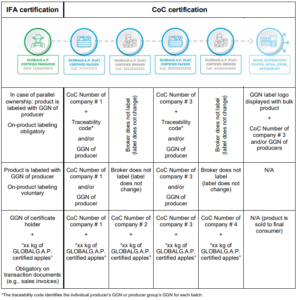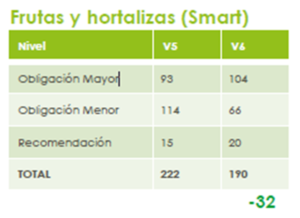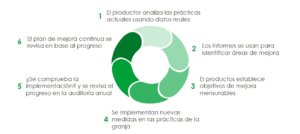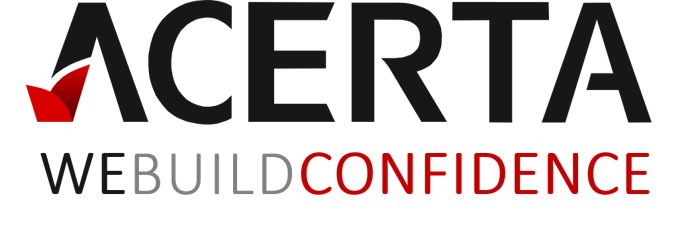21/11/2022
We inform you that the Secretariat of X has published a new edition of the Chain of Custody Standard: CoCv6.1. This CoCv6.1 edition will come into effect on January 1, 2023 and become mandatory on July 1, 2023.
At the moment the normative documents have been published only in English, below you can find the following documents related to general regulations and control points:


INFORMATION ABOUT THE NEW EDITION CoCv6.1
All chain of custody audits from 1 July 2023 must be performed under CoCv6.1. This includes internal audits.
What has changed?
General Regulations Update: The changes to the General Regulations (RG) are primarily clarifications of existing requirements. Compared to CoC v6.0, these changes are as follows:
- Language alignment with IFA version 6.
- Subcontractors: Clarification of the definition. Clarification of supported certification for subcontractors: IFA and PHA certificates have been included as accepted certifications for high-risk subcontractors.
- Clarification of the definition of the product mix.
- Definition of the scope of application for fruits and vegetables: now also the products that are processed are included. Processing may consist of cutting, slicing, dicing, freezing and/or quick freezing (IQF) to the extent that the original product is still visibly recognizable.
- New fields have been added to the CoC paper certificate template, which includes GGN and a list of high-risk subcontractors.
Applicable only to block 2 of the checklist “PART II. CHAIN OF CUSTODY STANDARD FOR OPERATORS OF RETAIL STORES AND RESTAURANT CHAINS”, (not included in the scope of ACERTA accreditation). Clarification of the sampling criteria for retail stores and restaurant chains. Need for CoC certification for restaurant chains and retail stores when selling products with the GLOBALG.A.P. claim. to other businesses outside of the retail network.
Update to checkpoints and compliance criteria: Some grammatical changes have been made, but the content and purpose remain the same. Compared to CoC v6.0, these changes are as follows:
- Changes in the structure (order of some points).
- Treatment of mass balance requirements.
- Address the communication of the new subcontractors to the certification entities (no more than 5 days from the start of the subcontracted activity).
- Address the use of the GGN logo visual label (“GGN LABEL”). _See clarifications below_.
- Two new recommendations addressing food losses and waste reduction targets.
- Clarification on the supplier authentication procedure (entry verification), it being necessary to include the GGN / CoC number only of the direct supplier (that is, the one from which the company purchases the products).
- Clarification that the traceability requirement through the identity preservation method or the segregation method is applicable to all types of products.
- Unification of the requirements related to product labeling at a single control point.
- Alignment with IFA v6 requirements on aquaculture.
Applicable only to block 2 of the checklist “PART II. CHAIN OF CUSTODY STANDARD FOR OPERATORS OF RETAIL STORES AND RESTAURANT CHAINS”, (not included in the scope of ACERTA accreditation). Create control point groups applicable to each area of the retail store or restaurant chain group (for example, head office, retail store distribution center, retail store, and restaurant).
Implementation of the GLOBALG.A.P. standard for the Chain of Custody. With fraud and food integrity issues becoming increasingly challenging for the industry, the GLOBALG.A.P. advisory committee chose to strengthen the GLOBALG.A.P. system and require strict implementation of the GLOBALG.A.P. Chain of Custody standard from 2023.
The deadline is coming. As of January 1, 2023, all parties handling loose and unpackaged products from GLOBALG.A.P.-certified production processes, as well as all parties packaging and labeling products with an GLOBALG.A.P. identification number (GGN / CoC Number) or that state in writing that a product comes from an GLOBALG.A.P.-certified production process, must have valid CoC certification.
To which companies the CoC certification applies: Mainly to companies that market, pack and sell products from GLOBALG.A.P.-certified production processes, but do not have an IFA certification for those same products that they wish to market with their certified status.
The following diagram shows at which point in the supply chain CoC certification is necessary:

Please refer to the following link to learn how to license the use of the GG tag logo https://www.globalgap.org/es/ggn-label/about-the-ggn-label/
We take the opportunity to provide you with the regulatory document
“Use of GLOBALG.A.P. Trademarks: Policy and Guidelines“, published this November in connection with the use of the mark GLOBALG.A.P.
We remind you that you can download the documents published by GLOBALG.A.P. through the document center of its website through the following link https://www.globalgap.org/es/documents/#
If you need to consult any aspect, do not hesitate to contact us.
Similiarities
Both have been developed from the IFAv5 standard with the full support of the GLOBALG.A.P. technical committees.
Same six issues, same holistic approach.
Issues of environmental sustainability, animal health and welfare, and worker welfare are covered in the same way in both editions.
The content and the user experience have been aligned as much as possible.
Differences
V6 Smart is intended for most growers. V6 GFS is specially adapted for GFSI.
The general regulation of the GFS edition has some additional requirements.
The principles and criteria (P&C) related to regulatory issues, management and traceability, food safety, and production processes are more prescriptive, to obtain GFSI approval.
Less than 15% of the P&C of the GFS and Smart editions are different. There is an additional P&C in the GFS edition for FV (total 190 vs. 191).
Compliance Levels: GFS edition has 15 more P&Cs classified as Mandatory. Older, while in v6 Smart these points are Oblig. Minors.
Recertification Audit: Remote audit (fully remote) is included as an emergency procedure for the Smart version only. It is not possible to obtain an initial certification based on a completely remote audit.
GLOBALG.A.P. GENERAL REGULATIONS
- The self-assessment contains comments for all non-applicable and non-compliant Major/Minor Musts criteria (ie no comments for all met Recommendations and Major/Minor Musts).
- 10% of the audits carried out by certification bodies must be unannounced. This 10% no longer counts as additional audits, but is included in the original number of certification audits.
- The three-year cycle rule (with annual on-site audit) further reduces the checklist content to applicable items and shortens the duration of the on-site audit.
o Initial audit (for v6): all requirements are included in the applicable checklists (QMS and farm).
o Next 2 (operational issues identified in the checklist).
o Next 3 (operational issues identified in the checklist). - Fewer principles and criteria in the IFAv6 standard than in the IFAv5 standard.

RESULTS-ORIENTED APPROACH
The approach of the IFAv6 standard focuses on the results obtained rather than on specific measures. This offers greater flexibility as it allows producers to demonstrate compliance in the manner most appropriate to their production practices.
RISK-BASED PRINCIPLES AND CRITERIA
Principles
- Rules that form the basis of a GLOBALG.A.P.
- Statements instead of questions.
- They describe the result to be achieved.
Criteria
- Methods that producers can use to demonstrate compliance with a principle.
- Compliance can be demonstrated with data, a procedure, a record, etc.
A GREATER FOCUS ON SUSTAINABILITY
The IFAv6 standard focuses more on environmental sustainability.
Some principles and criteria have been developed based on the IFAv5 checkpoints and compliance criteria, while some issues are new or more stringent.
Sustainability issues new to the IFAv6 standard:
- Greenhouse gases and climate change
- Ecosystem restoration
- Food waste management
- Plastics management
- Carbon neutrality
- Deforestation prevention
- Animal welfare
- The farm as an agricultural ecosystem
- Continuous improvement
Sustainability issues updated in the IFAv6 standard:
- Biodiversity
- Integrated pest management
- Soil management and conservation
- Water management
- Energy efficiency
- Waste management
- Fertilizers
- Phytosanitary products
CONTINUOUS IMPROVEMENT AT THE FARM LEVEL
The concept of “continuous improvement” refers to the frequent updating of farm insurance standards to improve continuously. In the IFAv6 standard, continuous improvement will first be relevant at the level of the individual producer.
- Producers should implement a plan to analyze current practices.
- They then identify ‘hot spots’ and set clear and measurable objectives for improvement in this area (eg improve energy efficiency, reduce use of plant protection product X).
- Year after year, producers demonstrate their efforts to improve sustainability, food safety or worker well-being.

